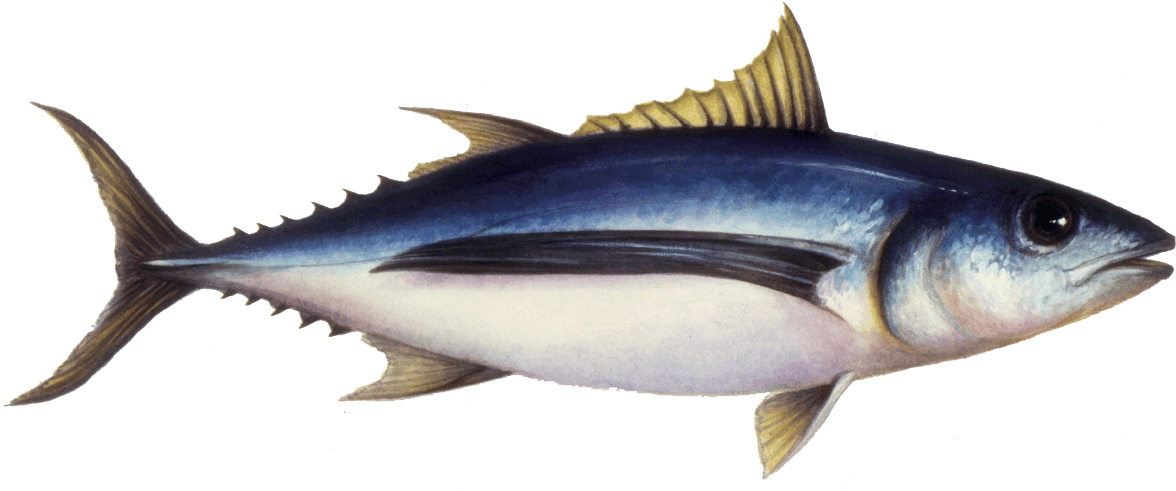Albacore Tuna: What to know, when & where to get it
Albacore Tuna
(Thunnus alalunga)
━━━━
(year-round, peaking in the summer)
Albacore are a favorite species of Pacific-caught tuna, often enjoyed raw, grilled, or smoked. They have a firm flesh and mild flavor, and they are a popular fish for canning.
Albacore have torpedo-shaped bodies with long pectoral fins and a metallic blue and silver-white coloration. Streamlined and powerful, they can swim up to 50 miles per hour and cover long distances during their annual migration. They are large fish, growing up to 80 pounds and 4 feet long.
You have likely eaten albacore before, whether you know it or not! Sustainably managed and responsibly harvested, this is the only tuna species that is labeled as “white meat.” It is commonly grilled or pan-cooked, but is also a go-to ingredient in raw fish dishes, like Japanese sushi or Hawaiian poke. Or pre-cooked in the can, it is a convenient protein for salads or sandwiches. The albacore stock is remarkably healthy in the Pacific Ocean. From mid-summer through early fall on the West Coast, fishermen use longlines or trolling to catch albacore.
While locally-landed albacore has been harder to find in Monterey Bay in recent years (these highly migratory species like to travel!), there are local fishermen who follow them up and down the coast. You can find albacore caught by West Coast fishermen in markets year-round, with the peak season falling during the summer months.
Photo by Joachim Langeneck
Buying Tips
Ask for local albacore from your fishmonger or community supported fishery (CSF) — fresh, frozen, or in the can.
━━━━
Be adventurous, and try a new preparation!
Seafood Illustration courtesy of Monterey Bay Aquarium®
Recipes
Seared Tuna with Japanese Salsa
(H & H Fresh Fish)
━━━━
Classic Tuna Poke
(Real Good Fish)
━━━━
Tuna Salad with Red Onion & Capers
(Bon Appetit)
More about Albacore
Albacore: life, habitat, and management
Albacore tuna (Thunnus alalunga) migrate annually across the northern Pacific Ocean, cycling from Japan to the US West Coast and back. They generally prefer tropical and warm temperate waters. Between March and July, albacore spawn with individual females often releasing 1 to 2 million eggs at once.
Albacore feed on smaller fish, including sardines, anchovies, and squid—sometimes eating up to 25% of their body mass in a single day. Due to their body structure, they must swim with their mouths open in order to push oxygen-rich water over their gills. Their most common predators are sharks, other tuna, and billfish.
On the West Coast, this fishery is managed under the Fishery Management Plan for U.S. West Coast Fisheries for Highly Migratory Species. The stock is healthy, and management is rated effective. Pacific-caught albacore tuna are currently harvested at sustainable levels according to the Monterey Bay Aquarium Seafood Watch, which lists them as a “Best Choice.”
SOURCES:
CA SeaGrant, NOAA, Seafood Watch, Environmental Defense Fund
Where & When to Find Albacore
Albacore is open year-round in Central and Northern California, with the peak season falling during the summer months.
You can buy this fish directly from local restaurants, grocery stores, and fish markets — check out our Local Catch page for more information, or check out our recipes page for tips on how to store, prepare, and cook this and other seafood.
Want a fun calendar to remind you of what is in season here in Monterey Bay? Download + print our seafood seasonality guide (downloadable pdf).




